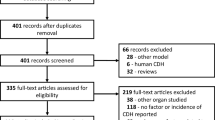Abstract
Nitrofen induces in rats diaphragmatic hernia (CDH) with heart and lung hypoplasia by a mechanism involving oxidation. The aim of this study was to examine if prenatal administration of the anti-oxidant agent vitamin E (VitE) prevents to some extent heart and lung hypoplasia. Pregnant rats received on E9.5 either 100 mg of nitrofen alone or followed by 150 IU of VitE on E16.5–E20.5. Control animals received either vehicle or VitE alone. The fetuses were recovered on E21. The hearts and lungs were weighed and DNA and proteins were measured. Sections of the heart and lung were immunohistochemically stained for ki-67, Tunel and TTF-1, and the proportions of proliferating, apoptotic and TTF-1-expressing cells were determined. Cultured human pneumocytes were exposed to the same agents and similarly processed. TTF-1 expression and the proportion of proliferating cells were quantitated. The ANOVA or Kruskall-Wallis tests were used for comparison with p<0.05 as threshold of significance. Nitrofen-exposed rats had decreased lung and heart weight/body weight ratios, lung and heart DNA and protein, lung TTF-1 expression and proportion of proliferating cells in lung and heart. Additional treatment with VitE ameliorated these decreases except for lung TTF-1 and heart weight. In cultured pneumocytes, TTF-1 expression was decreased by nitrofen and rescued by VitE. Cell proliferation followed the same pattern. Antioxidant VitE partially reverses the effects of nitrofen on the heart and lungs of exposed rats. The same effects are observed in cultured human pneumocytes. These results further substantiate the oxidative nature of the effects of nitrofen and suggest that anti-oxidant agents could have a potential clinical application.



Similar content being viewed by others
References
Alfonso LF, Arnaiz A, Alvarez FJ, Qi B, Diez-Pardo JA, Valls-i-Soler A, Tovar JA (1996) Lung hypoplasia and surfactant immaturity induced in the fetal rat by prenatal exposure to nitrofen. Biol Neonate 69:94–100
Alfonso LF, Vilanova J, Aldazábal P, López de Torre B, Tovar JA (1993) Lung growth and maturation in the rat model of experimentally induced congenital diaphragmatic hernia. Eur J Pediatr Surg 3:6–11
Bradford MM (1976) A rapid and sensitive method for the quantitation of microgram quantities of protein utilizing the principle of protein-dye binding. Anal Biochem 72:248–254
Cabrera G (2000) Effect of five dietary antimutagens on the genotoxicity of six mutagens in the microscreen prophage-induction assay. Environ Mol Mutagen 36:206–220
Fisher JC, Kling DE, Kinane TB, Schnitzer JJ (2002) Oxidation-reduction (redox) controls fetal hypoplastic lung growth. J Surg Res 106:287–291
Hatzenikolaou KP, Giala MM, Paradelis AG, Chatzinikolaou PK (1995) Ultrastructural changes of the myocardial and striated muscle following a challenge of normobaric hyperoxia: the protective effects of alpha-tocopherol. Methods Find Exp Clin Pharmacol 17:509–518
Iritani I (1984) Experimental study on embryogenesis of congenital diaphragmatic hernia. Anat Embryol 169:133–139
Islam S, Narra V, Cote GM, Manganaro TF, Donahoe PK, Schnitzer JJ (1999) Prenatal vitamin E treatment improves lung growth in fetal rats with congenital diaphragmatic hernia. J Pediatr Surg 34:172–176
Kim WG, Suh JW, Chi JG (1999) Nitrofen-induced congenital malformations of the heart and great vessels in rats: an animal model. J Pediatr Surg 34:1782–1786
Kluth D, Kangah R, Reich P, Tenbrinck R, Tibboel D, Lambrecht W (1990) Nitrofen-induced diaphagmatic hernia in rats: an animal model. J Pediatr Surg 25:850–854
Labarca C, Paigen K (1980) A simple, rapid and sensitive DNA assay procedure. Anal Biochem 72:344–352
Losada A, Santisteban P, Diez-Pardo JA, Tovar JA (2000) Nitrofen-induced hypoplasia: evidence of oxidative mechanisms for reduced TTF-1 activity. Thirteenth International Symposium on Pediatric Surgical Research, Ann Arbor, Michigan
Mendelsohn C, Lohnes D, Decimo D, Lufkin T, LeMeur M, Chambon P, Mark M (1994) Function of the retinoic acid receptors (RARs) during development (II). Multiple abnormalities at various stages of organogenesis in RAR double mutants. Development 120:2749–2771
Migliazza L, Otten C, Xia H, Rodriguez JI, Diez-Pardo JA, Tovar JA (1999) Cardiovascular malformations in congenital diaphragmatic hernia: human and experimental studies. J Pediatr Surg 34:1352–1358
Migliazza L, Xia H, Alvarez JI, Arnaiz A, Diez-Pardo JA, Alfonso LF, Tovar JA (1999) Heart hypoplasia in experimental congenital diaphragmatic hernia. J Pediatr Surg 34:706–710
Tenbrinck R, Tibboel D, Gaillard JLJ, Kluth D, Bos AP, Lachmann B, Molenaar JC (1990) Experimentally induced congenital diaphragmatic hernia in rats. J Pediatr Surg 25:426–429
Thebaud B, Barlier-Mur AM, Chailley-Heu B, Henrion-Caude A, Tibboel D, Dinh-Xuan AT, Bourbon JR (2001) Restoring effects of vitamin A on surfactant synthesis in nitrofen-induced congenital diaphragmatic hernia in rats. Am J Respir Crit Care Med 164:1083–1089
Thebaud B, Tibboel D, Rambaud C, Mercier JC, Bourbon JR, Dinh-Xuan AT, Archer SL (1999) Vitamin A decreases the incidence and severity of nitrofen-induced congenital diaphragmatic hernia in rats. Am J Physiol 277:L423–L429
Yu J, Gonzalez S, Diez-Pardo J, Tovar J (2002) Effects of vitamin A on malformations of neural crest-controlled organs induced by nitrofen in rats. Pediatr Surg Int 18:600–605
Acknowledgements
This work was supported in part by 99/003-01 and 02/1220 FIS (Fondo de Investigación Sanitaria) grants and a research fellowship from the the Hospital Universitario La Paz (SGR).
Author information
Authors and Affiliations
Corresponding author
Rights and permissions
About this article
Cite this article
Gonzalez-Reyes, S., Alvarez, L., Diez-Pardo, J.A. et al. Prenatal vitamin E improves lung and heart hypoplasia in experimental diaphargamatic hernia. Ped Surgery Int 19, 331–334 (2003). https://doi.org/10.1007/s00383-003-1005-6
Accepted:
Published:
Issue Date:
DOI: https://doi.org/10.1007/s00383-003-1005-6




